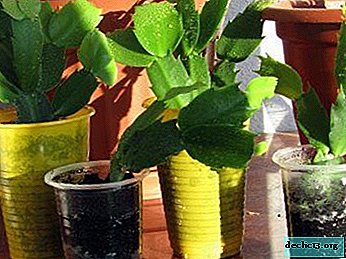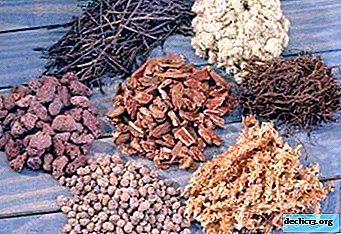Unpretentious indoor flower - Crassula lycopodioides (Crassula lycopodioides): description and photo, varieties and care

Plants belonging to the Tolstyankovs are pleasant in appearance and are distinguished by a wide variety of species and varieties. Hence their enduring popularity as a houseplant.
There is also a representative in the family who is able to surprise with his appearance, non-standard for fat women. The fluffy Crassula is pretty, unusual and has its own charm. This article will discuss the features of the species and its care, different varieties. Also, the reader is offered a variety of photos of the fat girl.
Description and specifications
Crassula lycopodioides, a plummy Crassula, is a representative of the class Dicotyledonous, family Tolstyankovye and the genus Tolstyanka. Fat women grow in the southern hemisphere. The fluffy fat woman hails from the arid, rocky regions of South and Southwest Africa.
Like other species of this family - succulent, stores water in its fleshy tissues.In appearance, the plant is radically different from relatives. Crassula lycopodioides does not have a tree trunk, thick, fairly wide leaves. It is very reminiscent of the oldest plants - the crowns. This krassula is a low shrub (up to 25 cm tall). The bush consists of flexible, non-woody, branched shoots. Very small green leaves adhere tightly to the stems, like snake scales, in four vertical rows. It turns out that the stem has four faces. The stems can be quite thick (up to five centimeters in diameter).
The plant blooms with small yellow flowers. They are not decorative: the crassula is plaiform, valued for the beauty of the stems. This species is often grown as ground cover. Shoots, growing to a maximum height, grow well in length. It can become a good background in a large capacity with other succulents.
The plant not only looks bewitching and distinctive. Crassula of this species also surprises with its unpretentiousness. Growing this plant is not easy, but very easy.. Crassula is floating-shaped - the plant is small, but long-lived: in good conditions it can adorn the windowsill for more than a dozen years.
Varieties Crassula Lycopodioides and their photos
Pseudolycopodioides (Pseudoplaid)
Crassula pseudoplaid - a species of Crassula lycopodioides, in which the stems are more curved, and the leaves do not cover the shoots so tightly. Therefore, the stems resemble a more magnificent plait. Leaves are both green and yellowish, silvery. Coloring can combine even several shades at once. The stems, in comparison with the floating, rush more in different directions, and not just strictly up.

Cristata (Cristata)
Crested forms of succulents are associated with a growth point mutation. It does not grow up, but is divided in breadth. The plant takes on the shape of a ridge. Thus, the shoots of the red-necked crested form in the upper part become flat, wide, as if in the form of an inverted triangle. Kristata has a very exotic look and is interesting to collectors.

Monstrosa (Monstrose)
The monstrous form of Crassula does not differ in attractive appearance. Monstrosity is a mutation when succulent grows at once with several points of growth. Such a plant is notable for its disharmonious appearance: kinks on the stems, random branching. The arrangement of leaves can be radically different than in the normal form.

Variegata (Variegata)
The variegated form of the plant is also formed as a result of a mutation. In such instances, some cells are not able to synthesize chlorophyll. Therefore, the leaves of variegate crassula are colored with inclusions of yellow, beige, reddish, pink shades. Decorative and beautiful!

Fragilis (Fragilis)
This is the smallest species of Crassula from the group of the Plaudidae. The plant reaches a maximum height of 10 cm. Fragilis has thin stems. Leaves in the shape of a ball, arranged in pairs.

Purpusii
In this species, fleshy triangular leaves grow at an angle to the stem, and do not fit tightly to it. Very decorative compact plant.

Crassula care at home
| Lighting | It is advisable to place the rossula so that at least 8 hours of sunlight gets on the plant ... |
| Temperature | In spring and summer - from 20 to 25aboutC. During the wintering period (from late autumn to spring) lower the temperature to 10-15 degrees. |
| Location | In the warm season, you can take to the loggia or to the garden. But it is desirable to place it in a shaded place so that the delicate stems do not burn the sun. You can plant this plant together with other succulents. |
| Watering | It is enough to water once a month during the period of active growth (in the warm season). In winter - once every six weeks. If the fat woman began to fade, extraordinary watering is necessary. |
| Air humidity | Crassula is a plant of arid regions; additional hydration is not necessary. |
| Top dressing | Fertilizer for cacti and succulents can be fed once a month in the warm season. It will optimally combine top dressing with watering. |
| The soil | Well-drained, loose, nutritious, but not too much. Use the prepared soil for cacti and succulents. Or prepare the soil yourself: turf land + leaf + river well washed sand. Be sure to add pieces of broken brick, as well as vermiculite, for good drainage. It would be nice to add activated charcoal to prevent root decay. |
| Pruning | Does not need special pruning. If you need a stalk for propagation, you can just gently break it off. |
Features of the species: reproduction, transplantation, possible difficulties
The fluffy Crassula breeds very easily, sometimes without human intervention. The easiest way is grafting. Cuttings do not even need to be dried, like other fat women. You can immediately plant in the ground. Sometimes shoots broken off by chance take root by themselves. It can be propagated by layering. A layering is formed from a shoot that has sunk to the ground and has given roots, in this place a new small plant begins to grow. You can also share the overgrown bushes.
A transplant will be needed if the fat woman has grown too large. In order not to damage the roots, we move the flower to another container along with a lump of earth on them.
Too voluminous Crassule pot is not suitable: it is better to choose a shallow and only slightly larger in volume than the plant itself.It is easier to grow a plum-like fatty than most other succulents (although many of them are very unpretentious). Crassula is not susceptible to attack by parasites or viral infections, like other plants. The main problem may be overflow and decay of the roots. If dark spots form on the plant, the stems begin to rot - you need to remove the damaged parts of the plant, urgently stop the soil overmoistening! It may be necessary to transplant the plant into fresh soil.
We suggest watching a video on how to propagate a plant:
Similar Succulents
- Stapelia grandiflora. Large-flowered stapelia. Succulent from the Lastovnev family. If you like exotic multifaceted stalks of the Crassulaceae pluvoida and would like to supplement the collection with something in the same spirit - you will like the stapelia. There can be even more than four faces at the stem. In addition, this plant is unpretentious and blooms with chic "fluffy" lilac-red flowers. Despite the fact that the flowers exude a rather unpleasant aroma, stapelia is very popular with gardeners.
- Pachyphytum compactum. Pachyphytum is compact. A miniature plant with an amazing appearance. In this succulent, the leaves, like that of the crassula, are also covering the entire stem. But it looks very different. The leaves are voluminous, reminiscent in shape of the buds of trees. The stems are practically invisible, the gaze clings to whole "inflorescences" of plump green "buds". Looks cute!
- Sedum morganianu. Scum of Morgan. The famous "monkey tail", long ago settled down in our country. It is everywhere, from apartments and study rooms to teachers and kindergartens! Long hanging stems up to a meter long, fleshy voluminous pointed leaves at the ends, "chain mail" growing along the entire length of the stem. A familiar plant, but it will never lose popularity among fans of decorative succulents. The leaves have a characteristic bluish plaque.
- Sedum burrito. Cedum Burrito. Another stonecrop, no less interesting. Unlike the sedum of Morgan, this species has leaves that are more reminiscent of balls in shape. It does not have a bluish coating, just a juicy green color.
- Sedum rupestre "Angelina". Stonecrop "Angelina". Another cool variety for those who like plants that resemble horsetail or plun. Wonderful Christmas tree stems with thick needles growing fervently upwards. And all this beauty is in yellow-pink tones!
At first glance, the fat woman will subdue the lover of succulents in general and crassula in particular. The plant impresses with its appearance, dispensing with luxurious flowering. Many people note that admiring this crassula carries a certain anti-stress charge. Thanks to its undemandingness, it will suit even the most busy connoisseur of beautiful home flora.

















